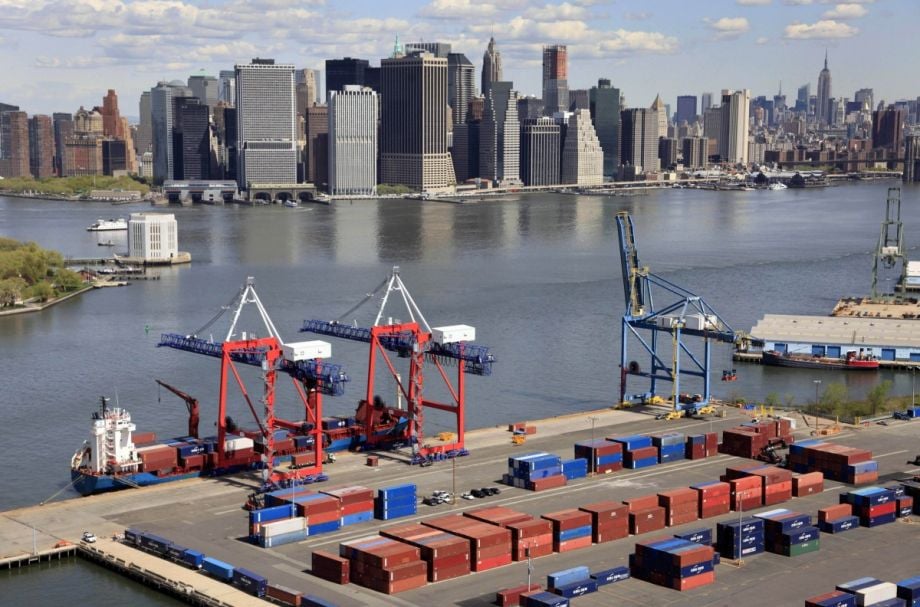“If you look outside the windows of this ship right now, you don’t see a lot of merchant ships,” Clay Maitland recently told several hundred people on a yacht docked in the Hudson River. “But if you fly over the Verrazano Bridge, you see a whole lot of them approaching the Port of New York and New Jersey … . They are headed to Port Newark and Port Elizabeth, the big container terminals.”
In other words, although the New York metro region remains one of the nation’s largest ports, the work — and jobs — have leaked from Manhattan. There were once more than 60,000 longshoremen in New York, with “blue-collar” waterfront jobs scattered across all five boroughs. In the 1960s and ’70s, several factors, including larger ships, the beginnings of containerization, and the general trend of white flight and suburbanization, pushed those jobs to New Jersey and Staten Island. Their number has been dwindling ever since.
According to Kevin Corbett, of infrastructure design-build firm AECOM, shipping companies are now making a tradeoff: “As industry is pumping billions into cranes, ships, infrastructure, they’re trying to be as efficient as possible in labor.”
Corbett and Maitland spoke on a recent panel during the Metropolitan Waterfront Alliance’s floating conference. Two elected officials who have made names for themselves on waterfront issues also participated, discussing whether they saw a way forward on bringing those jobs back.
U.S. Congressman Jerrold Nadler, whose district includes much of south Brooklyn’s waterfront, thinks it’s an “exciting time … because people are finally beginning to realize that we have to have a port on both sides of the harbor,” but he was blunt about the current port system’s vulnerability. Although two-thirds of the market for goods in the New York City area is east of the Hudson, only Red Hook Container Terminal, the smallest port facility, is located there. There is no freight-rail connection across New York Harbor, making NYC “the only city in North America where everything comes in by truck,” according to Nadler. And because the FBI has the ability to shut down the George Washington Bridge instantly, a single national-security scare could cripple the distribution of goods in the region.
City Councilman Carlos Menchaca represented Brooklyn’s Red Hook and Sunset Park on the panel. This winter he courted controversy when he held up a redevelopment deal over disputes about local control of South Brooklyn Marine terminal. The de Blasio administration plans to redevelop maritime facilities and revive rail service at the terminal, which has been inactive for more than 20 years. (Menchaca has since given the project his approval, and the city is moving forward.)
Menchaca’s vision of a successful waterfront entails deepening the links between nature and industry. Last November in Sunset Park, the city opened 22-acre Bush Terminal Piers Park, a harborfront space that includes athletic fields and a small nature preserve. “Sunset Park should understand that rail connected to a marine terminal is unique and a big deal,” Menchaca said. A truly integrated waterfront would only be achieved by providing robust community benefits, training local residents for waterfront jobs and teaching harbor stewardship to local young people.
If there was an area of unanimous agreement among panelists, it was that the Red Hook Container Terminal should be kept open until (and ideally after) a new facility in Sunset Park is up and running. Nadler accused the Bloomberg administration of making a major blunder last decade by refusing to meet with the shipping conglomerate Hanjin after the company expressed interest in bringing maritime industries back to Sunset Park and Red Hook. Despite the occasional rumors that Red Hook will sprout new condos, Nadler still expressed hope that “the economic imperative there is so great that we will probably get considerable interest.” Nobody wants to be the one who let the money escape to Jersey.

Jordan Fraade is a Brooklyn-based freelance journalist. His work on urban planning and city politics has been featured in Gothamist, CityLab, BKLYNR and The Baffler.
















